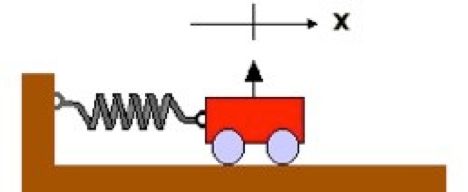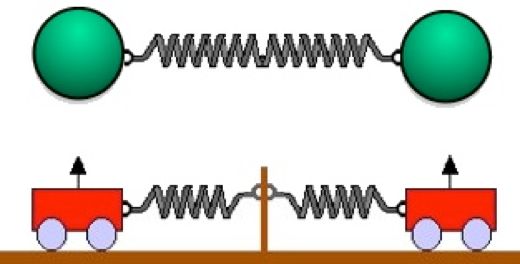
College Physics
11th Edition
ISBN: 9781305952300
Author: Raymond A. Serway, Chris Vuille
Publisher: Cengage Learning
expand_more
expand_more
format_list_bulleted
Concept explainers
Topic Video
Question
B. If the spring constant is k = 2.2 N/m, can you find the mass of the cart? If you can do it, give the answer here. If you can't, put 0.
m = _______ kg
| The simple mass on a spring is the basis for our description of almost any oscillation. Lets consider the vibrational states of a simple diatomic molecule, say N2. We will model it as two identical masses connected by a spring as shown in the figure at the top right. This is a little different from the cart on a spring since there is no wall -- both of the atoms are moving. But if we only look at oscillations of the molecule where the center of mass is not moving, the atoms are moving equally and oppositely. When one is going left, the other goes an equal amount to the right and vice versa. This is like two carts attached to a wall and oscillating equally and oppositely as shown in the lower picture. The only difference is the way we treat the spring. When each atom moves a distance x, the spring between the atoms actually stretches a distance 2x, so the force on each atom is -2kx. We can therefore model the motion of one of the nitrogen atoms as a single cart on a spring if we replace k by 2k. |
C. If the angular frequency of oscillation of N2 is found to be 4.5 x 1018 rad/s, and the mass of a single nitrogen atom is 2.3 x 10-26 kg, find the effective spring constant between the two atoms. (Give your answer in N/nm, since nanometers is a more appropriate scale for atoms than meters.)
k = _______ N/nm

Transcribed Image Text:- х

Expert Solution
This question has been solved!
Explore an expertly crafted, step-by-step solution for a thorough understanding of key concepts.
This is a popular solution
Trending nowThis is a popular solution!
Step by stepSolved in 3 steps with 3 images

Knowledge Booster
Learn more about
Need a deep-dive on the concept behind this application? Look no further. Learn more about this topic, physics and related others by exploring similar questions and additional content below.Similar questions
- A.5 After deposition of an Al film, the basic frequency of the quartz crystal monitor (10 MHz) is shifted by 10 Hz. Calculate the amount of deposited Al. The answer should be expressed in thickness units (Å). Assume the density of the Al film to be the same of as for bulk metal Al (2.70 g/cm³).arrow_forwardSuppose a large spherical object, such as a planet, with radius R and mass M has a narrow tunnel passing diametrically through it. A particle of mass m is inside the tunnel at a distance x ï. Part A Find an expression for the magnitude of the gravitational force on the particle, assuming the object has uniform density. Express your answer in terms of the variables x, R, m, M, and gravitational constant G.arrow_forwardPlease help. This problem involves finding the radius and volume of a platinum atom using its density. Thank you.arrow_forward
- For this problem, we want to estimate the answer, so our assumptions may be a little unrealistic. Suppose we want to estimate how much air we need to send to a space station, assuming we cannot recycle air. Suppose four astronauts are in a spherical space station. If each of them typically breathes about 500 cm³of air with each breathe, and take 15 breathes per minute (average resting value): a. What is the volume of air you would need in the space station if these four astronauts stayed for a full year? b. If the density of air is 1.25 kg/m³ and it costs (thanks to SpaceX) a mere $100/kg to send objects to the space station, how much money would the astronaut air supply cost?arrow_forwardI am having a hard time finding the meaning of what T2 is in the equation. Do I just square the T or do something else? Thanks for the help in advanced.arrow_forwardpart A and Barrow_forward
- For Parts I and II, use the pendulum equation and solve to predict the length needed for a pendulum with a period of 1 s and 2 s respectively. Use a piece of string (or thread, dental floss, shoe lace, etc.) and a steel nut (or washer or something small but with enough mass to weigh down the string) to build each pendulum. Time each pendulum for 30 periods and then find the average time for one period. Remember, a period is the time to complete one cycle of motion, out and back. Tape each pendulum up in perhaps a doorway where it is stationary and has room to swing. Be precise with your measuring and timing. Show your work. Part I Given: T = 1.00 s l =? Part II Given: T = 2.00 s l =?arrow_forwardPART A k = 2.000 N/m M=0.125kg %3D A 0.125kg mass is attached to a horizontal spring of spring constant k = 2 N/m and set into oscillation. Assume frictionless floor. What is the angular frequency o of the vibration? o = How about the vibrating frequency f in Hz? f = The position of the mass is given as x = A cos (ot + o). With your calculated value of w, fill in the following table (don't forget to set your calculator to "radian mode"). Each row represents a different oscillation with the same spring, pay attention to sign: А (m) x (m) v (m/s) a (m/s?) t (s) фо (rad) F (N) 0.03 2.5 0.3 0.04 0.02 0.2 0.06 0.1 0.4 0.04 0.3 -0.2 0.5 0.04 0.1 0.1arrow_forwardDisplayed is a series of mathematical equations involving vectors. Each of the equations contains an error. In the equations, '×' is the cross product operator and '∙' is the dot product operator. To the left of each equation, identify the error in the equation. On the right side, identify the correction that produces a well‑defined equation. Error Correction (a) C=A→B→ (b) C→=A→B→ (c) C=A→×B→ (d) C=AB→ (e) C→=A×B→ (f) A→∙B→=A→×B→ (g)…arrow_forward
- The Statue of Liberty in New York City is approximately 305 ft305 ft tall. How many U.S. dimes would be in a stack of the same height? Each dime is 1.35 mm1.35 mm thick. number of dimes: Each dime has a mass of 2.268 g.2.268 g. How much would the stack of dimes from the previous question weigh? mass: g What is the value, in dollars, of the same stack of dimes? value: dollars The 2017 U.S. gross domestic product (GDP) was valued at 19,390,604,000 dollars.19,390,604,000 dollars. How many Statue of Liberty‑height stacks of dimes are needed to match the GDP in value? number of stacks:arrow_forwardPart A: The position of a 40 gg oscillating mass is given by x(t)=(2.0cm)cos(10t)=(2.0cm)cos(10t), where t is in seconds. Determine the velocity at t=0.40s=0.40s. Express your answer in meters per second to two significant figures. Part B: Assume that the oscillating mass described in Part A is attached to a spring. What would the spring constant k of this spring be? Express your answer in newtons per meter to two significant figures. Part C: What is the total energy E of the mass described in the previous parts? Express your answer in joules to two significant figures.arrow_forwardNeeds Complete typed solution with 100 % accuracy.arrow_forward
arrow_back_ios
SEE MORE QUESTIONS
arrow_forward_ios
Recommended textbooks for you
 College PhysicsPhysicsISBN:9781305952300Author:Raymond A. Serway, Chris VuillePublisher:Cengage Learning
College PhysicsPhysicsISBN:9781305952300Author:Raymond A. Serway, Chris VuillePublisher:Cengage Learning University Physics (14th Edition)PhysicsISBN:9780133969290Author:Hugh D. Young, Roger A. FreedmanPublisher:PEARSON
University Physics (14th Edition)PhysicsISBN:9780133969290Author:Hugh D. Young, Roger A. FreedmanPublisher:PEARSON Introduction To Quantum MechanicsPhysicsISBN:9781107189638Author:Griffiths, David J., Schroeter, Darrell F.Publisher:Cambridge University Press
Introduction To Quantum MechanicsPhysicsISBN:9781107189638Author:Griffiths, David J., Schroeter, Darrell F.Publisher:Cambridge University Press Physics for Scientists and EngineersPhysicsISBN:9781337553278Author:Raymond A. Serway, John W. JewettPublisher:Cengage Learning
Physics for Scientists and EngineersPhysicsISBN:9781337553278Author:Raymond A. Serway, John W. JewettPublisher:Cengage Learning Lecture- Tutorials for Introductory AstronomyPhysicsISBN:9780321820464Author:Edward E. Prather, Tim P. Slater, Jeff P. Adams, Gina BrissendenPublisher:Addison-Wesley
Lecture- Tutorials for Introductory AstronomyPhysicsISBN:9780321820464Author:Edward E. Prather, Tim P. Slater, Jeff P. Adams, Gina BrissendenPublisher:Addison-Wesley College Physics: A Strategic Approach (4th Editio...PhysicsISBN:9780134609034Author:Randall D. Knight (Professor Emeritus), Brian Jones, Stuart FieldPublisher:PEARSON
College Physics: A Strategic Approach (4th Editio...PhysicsISBN:9780134609034Author:Randall D. Knight (Professor Emeritus), Brian Jones, Stuart FieldPublisher:PEARSON

College Physics
Physics
ISBN:9781305952300
Author:Raymond A. Serway, Chris Vuille
Publisher:Cengage Learning

University Physics (14th Edition)
Physics
ISBN:9780133969290
Author:Hugh D. Young, Roger A. Freedman
Publisher:PEARSON

Introduction To Quantum Mechanics
Physics
ISBN:9781107189638
Author:Griffiths, David J., Schroeter, Darrell F.
Publisher:Cambridge University Press

Physics for Scientists and Engineers
Physics
ISBN:9781337553278
Author:Raymond A. Serway, John W. Jewett
Publisher:Cengage Learning

Lecture- Tutorials for Introductory Astronomy
Physics
ISBN:9780321820464
Author:Edward E. Prather, Tim P. Slater, Jeff P. Adams, Gina Brissenden
Publisher:Addison-Wesley

College Physics: A Strategic Approach (4th Editio...
Physics
ISBN:9780134609034
Author:Randall D. Knight (Professor Emeritus), Brian Jones, Stuart Field
Publisher:PEARSON